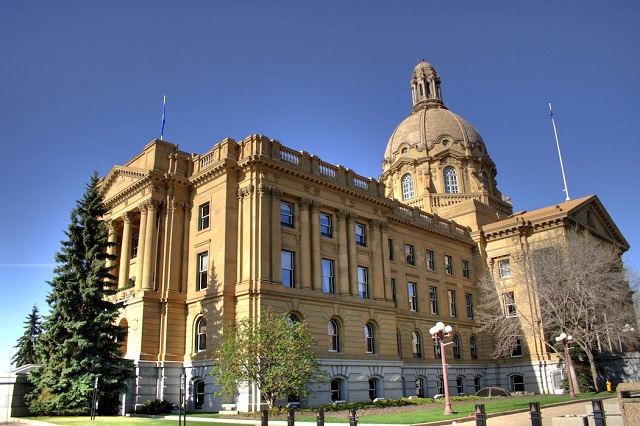Alberta
Alberta government should undo personal income tax hikes

From the Fraser Institute
By Tegan Hill and Nathaniel Li
If the Smith government reduced Alberta’s top PIT rate to 8 per cent, it would be the lowest provincial rate in Canada and Alberta would have one of the lowest top combined PIT rates in North America (41.0 per cent). Put simply, the change would go a long way to restoring Alberta’s previous tax advantage. And approximately 2.3 million Albertans would save $1,573 per year (on average)
On the campaign trail, Danielle Smith promised to create a new 8 per cent tax bracket for personal income below $60,000. While the tax cut was delayed in the recently tabled 2024 budget, it remains a good idea—in fact, Premier Smith should go a step further and create a single tax rate of 8 per cent for personal income.
First, some context.
As recently as 2014, Alberta had the lowest top combined (that is, provincial and federal) personal income tax (PIT) rate in North America. Paired with a low business income tax rate and no sales tax, Alberta had a powerful tax advantage that made the province a very attractive place to work and invest.
But in 2015, the NDP government replaced Alberta’s single personal income tax rate of 10 per cent with a five-bracket system including a top marginal rate of 15 per cent.
As a result, as noted in a new study published by the Fraser Institute, Alberta now has the 10th highest combined PIT rate in North America. And crucially, higher than rates in U.S. energy jurisdictions such as Texas, Wyoming, Oklahoma, Colorado, Louisiana, North Dakota and Alaska, which compete with Alberta for talent and investment.
If the Smith government reduced Alberta’s top PIT rate to 8 per cent, it would be the lowest provincial rate in Canada and Alberta would have one of the lowest top combined PIT rates in North America (41.0 per cent). Put simply, the change would go a long way to restoring Alberta’s previous tax advantage. And approximately 2.3 million Albertans would save $1,573 per year (on average), which means more money in the pockets of Albertans.
Moreover, a significant body of research finds that high income tax rates discourage economic growth by reducing after-tax income from work, savings, investment and entrepreneurship. Correspondingly, high income tax rates tend to negatively affect economic growth while lower rates stimulate economic activity. In other words, this tax change could come with big economic benefits to Albertans by attracting investment and high-skilled workers that fuel innovation and job creation.
Finally, this tax change may be more fiscally feasible than one might think. Based on budget data from the Smith government, reducing Alberta’s multi-bracket PIT system to a single rate of 8 per cent would’ve led to an estimated revenue loss of $3.8 billion in 2023/24, which is equivalent to just 5.1 per cent of total provincial government revenue that year. And the behavioural affect from lower taxes—increased work, savings and investment—could dramatically reduce the amount of revenue lost.
It’s time the Smith government make good on its campaign promise and finally undo the personal income tax hikes by the previous NDP government. Returning to a single-rate personal income tax system would help restore the province’s lost tax advantage and attract the entrepreneurs, businesses and investment that fuel a strong economy.
Authors:
Alberta
Median workers in Alberta could receive 72% more under Alberta Pension Plan compared to Canada Pension Plan

From the Fraser Institute
By Tegan Hill and Joel Emes
Moving from the CPP to a provincial pension plan would generate savings for Albertans in the form of lower contribution rates (which could be used to increase private retirement savings while receiving the same pension benefits as the CPP under the new provincial pension), finds a new study published today by the Fraser Institute, an independent, non-partisan Canadian public policy think-tank.
“Due to Alberta’s comparatively high rates of employment, higher average incomes, and younger population, Albertans would pay a lower contribution rate through a separate provincial pension plan while receiving the same benefits as under the CPP,” said Tegan Hill, director of Alberta policy at the Fraser Institute and co-author of Illustrating the Potential of an Alberta Pension Plan.
Assuming Albertans invested the savings from moving to a provincial pension plan into a private retirement account, and assuming a contribution rate of 5.85 per cent, workers earning the median income in Alberta ($53,061 in 2025) could accrue a stream of retirement payments totalling $454,741 (pre-tax)—a 71.6 per cent increase from their stream of CPP payments ($264,968).
Put differently, under the CPP, a median worker receives a total of $264,968 in retirement income over their life. If an Alberta worker saved the difference between what they pay now into the CPP and what they would pay into a new provincial plan, the income they would receive in retirement increases. If the contribution rate for the new provincial plan was 5.85 per cent—the lower of the available estimates—the increase in retirement income would total $189,773 (or an increase of 71.6 per cent).
If the contribution rate for a new Alberta pension plan was 8.21 per cent—the higher of the available estimates—a median Alberta worker would still receive an additional $64,672 in retirement income over their life, a marked increase of 24.4 per cent compared to the CPP alone.
Put differently, assuming a contribution rate of 8.21 per cent, Albertan workers earning the median income could accrue a stream of retirement payments totaling $329,640 (pre-tax) under a provincial pension plan—a 24.4 per cent increase from their stream of CPP payments.
“While the full costs and benefits of a provincial pension plan must be considered, its clear that Albertans could benefit from higher retirement payments under a provincial pension plan, compared to the CPP,” Hill said.

Illustrating the Potential of an Alberta Pension Plan
- Due to Alberta’s comparatively high rates of employment, higher average incomes, and younger population, Albertans would pay a lower contribution rate with a separate provincial pension plan, compared with the CPP, while receiving the same benefits as under the CPP.
- Put differently, moving from the CPP to a provincial pension plan would generate savings for Albertans, which could be used to increase private retirement income. This essay assesses the potential savings for Albertans of moving to a provincial pension plan. It also estimates an Albertan’s potential increase in total retirement income, if those savings were invested in a private account.
- Depending on the contribution rate used for an Alberta pension plan (APP), ranging from 5.85 to 8.2 percent, an individual earning the CPP’s yearly maximum pensionable earnings ($71,300 in 2025), would accrue a stream of retirement payments under the total APP (APP plus private retirement savings), yielding a total retirement income of between $429,524 and $584,235. This would be 22.9 to 67.1 percent higher, respectively, than their stream of CPP payments ($349,545).
- An individual earning the median income in Alberta ($53,061 in 2025), would accrue a stream of retirement payments under the total APP (APP plus private retirement savings), yielding a total retirement income of between $329,640 and $454,741, which is between 24.4 percent to 71.6 percent higher, respectively, than their stream of CPP payments ($264,968).

Joel Emes
Alberta
Alberta ban on men in women’s sports doesn’t apply to athletes from other provinces

From LifeSiteNews
Alberta’s Fairness and Safety in Sport Act bans transgender males from women’s sports within the province but cannot regulate out-of-province transgender athletes.
Alberta’s ban on gender-confused males competing in women’s sports will not apply to out-of-province athletes.
In an interview posted July 12 by the Canadian Press, Alberta Tourism and Sport Minister Andrew Boitchenko revealed that Alberta does not have the jurisdiction to regulate out-of-province, gender-confused males from competing against female athletes.
“We don’t have authority to regulate athletes from different jurisdictions,” he said in an interview.
Ministry spokeswoman Vanessa Gomez further explained that while Alberta passed legislation to protect women within their province, outside sporting organizations are bound by federal or international guidelines.
As a result, Albertan female athletes will be spared from competing against men during provincial competition but must face male competitors during inter-provincial events.
In December, Alberta passed the Fairness and Safety in Sport Act to prevent biological men who claim to be women from competing in women’s sports. The legislation will take effect on September 1 and will apply to all school boards, universities, as well as provincial sports organizations.
The move comes after studies have repeatedly revealed what almost everyone already knew was true, namely, that males have a considerable advantage over women in athletics.
Indeed, a recent study published in Sports Medicine found that a year of “transgender” hormone drugs results in “very modest changes” in the inherent strength advantages of men.
Additionally, male athletes competing in women’s sports are known to be violent, especially toward female athletes who oppose their dominance in women’s sports.
Last August, Albertan male powerlifter “Anne” Andres was suspended for six months after a slew of death threats and harassments against his female competitors.
In February, Andres ranted about why men should be able to compete in women’s competitions, calling for “the Ontario lifter” who opposes this, apparently referring to powerlifter April Hutchinson, to “die painfully.”
Interestingly, while Andres was suspended for six months for issuing death threats, Hutchinson was suspended for two years after publicly condemning him for stealing victories from women and then mocking his female competitors on social media. Her suspension was later reduced to a year.
-

 Addictions2 days ago
Addictions2 days agoWhy B.C.’s new witnessed dosing guidelines are built to fail
-

 Frontier Centre for Public Policy2 days ago
Frontier Centre for Public Policy2 days agoCanada’s New Border Bill Spies On You, Not The Bad Guys
-

 Business1 day ago
Business1 day agoCarney Liberals quietly award Pfizer, Moderna nearly $400 million for new COVID shot contracts
-

 Business1 day ago
Business1 day agoMark Carney’s Fiscal Fantasy Will Bankrupt Canada
-

 Energy2 days ago
Energy2 days agoCNN’s Shock Climate Polling Data Reinforces Trump’s Energy Agenda
-

 Opinion1 day ago
Opinion1 day agoCharity Campaigns vs. Charity Donations
-

 Red Deer1 day ago
Red Deer1 day agoWesterner Days Attraction pass and New Experiences!
-

 COVID-191 day ago
COVID-191 day agoTrump DOJ dismisses charges against doctor who issued fake COVID passports








